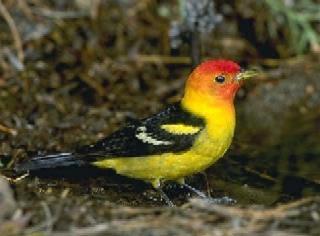 The
Western Tanager (Piranga ludoviciana) is in the family of warblers that includes
sparrows and cardinals.
The
Western Tanager (Piranga ludoviciana) is in the family of warblers that includes
sparrows and cardinals. 
The Western Tanager
PCMC's
2006 trip to Black Mountain was earlier than most other years, and we were
greeted by these colorful festive birds that no one recalled seeing on past
visits. As they were busy foraging for their kids, they didn't sit still long
for our cameras - this is the best shot we got:
 The
Western Tanager (Piranga ludoviciana) is in the family of warblers that includes
sparrows and cardinals.
The
Western Tanager (Piranga ludoviciana) is in the family of warblers that includes
sparrows and cardinals. 
The breeding male has a bright yellow body, red head, orange nape, black back
and tail and black wings with white bars, while the female is olive-gray above
and more yellowish below, with yellow wing bars. While incubating the female
doesnít normally leave the nest, so itís not seen foraging as often as the male.
Nests are in the trees, around the 30-foot level. A long-range migratory bird,
it winters in Mexico and Central America and migrates to open coniferous forests
in western North America to breed. The eggs incubate for about 2 weeks. The
Western Tanager eats insects, including ants on the ground, and fruit.
[This page contains a 290KB sound file.]